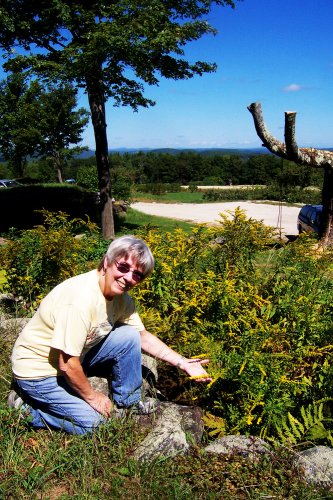Goldenrod wildflowers take center stage in late summer and early autumn after many other flowers have folded for the season. Their profusion of golden color in open fields and along roadsides gives a radiant charm to autumn landscapes. The goldenrod is the state flower for Kentucky and Nebraska.
The goldenrod's generic name, solidage, comes from two Greek words meaning “to make whole,” with reference to the plant's medicinal qualities. Throughout history, parts of the goldenrod plant have been used as a remedy for a variety of ailments like sore throats and headaches. Some Native Americans chewed a poultice of goldenrod roots to relieve the pain of toothaches.
Worldwide, there are about 125 different species of goldenrods, almost 50 of which grow in New England. The most common one in our area is the Canada goldenrod.
Neltje Blanchan wrote in Wildflowers “To name all the species of goldenrod by sight is a feat probably no one living can perform.”
When the American colonists boycotted English tea in the early 1770s, they brewed a hot drink from the leaves of the anise-scented goldenrod and called it “liberty tea.” A pleasant fragrance will be produced if you crush in your hands the leaves of the sweet goldenrod.
Hundreds of tiny florets make up the larger composite goldenrod flower at the top of a tall rod-like stem which is smooth and rigid. The many minute flowers become a popular restaurant for insects. In The Secrets of Wildflowers, Jack Sanders wrote, “Bees harvest the nectar of the goldenrod in great quantities in the flower-starved autumn.”
Deer shun goldenrod plants, which are distasteful to grazing animals. Don't blame goldenrods for hay fever allergies because their pollen is too moist and sticky to be carried by the wind.
The next time you walk through a patch of goldenrod wildflowers, look carefully at the stems, where eventually you may see a small bulge. This is a gall caused by an insect that lays an egg in the stem. The larva that hatches from the egg will make the stem swell, providing food and shelter for the larva. All winter, the larva remains dormant in the gall, and when spring arrives, a winged adult insect will emerge through a small hole in the gall. These insects will spend just two weeks of their entire life cycle as flying adults, during which time they mate and the females will lay more eggs in goldenrod stems.
This past summer, my wife and I went by boat to an outdoor chapel on an island in the middle of Squam Lake. The guest clergy in the worship service spoke about the “golden rule of nature.” Behind him on a granite boulder was a beautiful vase made of white birch bark containing a lovely floral arrangement. The flowers were goldenrods shining brilliantly in the sun, visual aids helping the minister deliver his sermon.
“Do unto nature as you want nature to do to you,” said the minister – truly, the golden rule of nature.






















